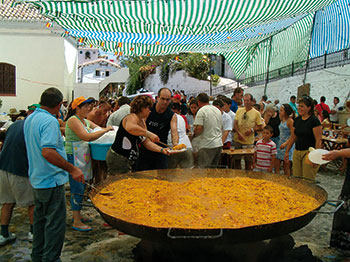Hola España!
Career strategies for young European scientists
by Ralf Schreck, Labtimes 06/2009
Spain has much to offer when it comes to culture, climate and lifestyle. It is amongst the world’s top three holiday destinations. But can Spain also attract young scientists from abroad?
Last year, the Spanish Minister of Science and Innovation, Cristina Garmendia, announced that Spain needs an additional 50,000 highly qualified scientists, irrespective of nationality, for its research to gain momentum. Here, Lab Times will report on the latest developments in Spain and also introduce a few exceptional biomedical research institutes. Despite recent cuts to its science budget, Spain provides excellent career opportunities for foreign research talent. Find out whether a spell in Spain could benefit your career as well as your suntan!
Inventory
Spain is divided into 17 autonomous communities with substantial legislative and executive autonomy, even when it comes to research and innovation. Spanish and Castilian are the official national languages. However, there are also a number of regional languages including Catalan, Galician and Basque. English is not widely spoken. If you are browsing the Spanish net for jobs or funding opportunities, do not expect to find too many details in English.
With about 46 million citizens, Spain is the fifth largest European country and still belongs to the world’s ten leading economies. Due to the current economic crisis, its unemployment rate is likely to reach 20% next year according to the Organization for Economic Co-Operation and Development (OECD). Expenses for research and development steadily increased to E12 billion or 1.27% of gross domestic product in 2007. A recent OECD report identified future challenges for Spanish innovation: scattered public research funding, low impact of scientific output, poor innovativeness of companies, lack of researcher mobility and weak co-ordination of innovation policy. To meet these challenges several national plans and programmes are in place, including INGENIO 2010, the sixth National Working Plan for Research, Development and Innovation (2008-11), and the long-term National Strategy on Science and Technology (2008-15).
All over the country more than 80 science and technology parks have been established. They provide lab space and infrastructure and promote technology transfer and collaboration among companies, research centres and other organisations located in the park. For example, the University of Barcelona founded the Barcelona Science Park, the first of its kind, in 1997. It is currently home to four research institutes, 75 companies and about 70 research groups with more than 2,200 employees and is still expanding. Besides regional money, the establishment of these parks was made possible by funds from the European Union. Plenty of European money will also be provided between 2007 and 2013. About E12 billion from the European Cohesion Fund, the Regional Development Fund and the Social Fund is foreseen for Spanish research, innovation and entrepreneurship.
In the 2009 THE-QS World University Rankings, only the University of Barcelona made it into the top 200 overall. In the Biomedicine and Life Sciences category the University of Barcelona was again the leading Spanish university at position 107, followed by the University of Complutense Madrid, Universidad Autónomade Madrid, Universidad Autónoma de Barcelona and the University of Granada, all placed somewhere between 176 and 279. According to SCIMAGO, Spain is not among the 10 leading nations when it comes to publication categories including neuroscience, biochemistry/genetics and molecular biology, immunology and microbiology, and medicine. In addition, overall patenting activity is quite low. So far, only two Spaniards have been honoured with the Nobel Prize in Physiology or Medicine: the anatomist Santiago Ramón y Cajal in 1906 and the biochemist Severo Ochoa in 1959.
Spain is an active and full member of many international and European organisations and large facilities including EMBO, ESA and CERN. Latest developments include the opening of the Iberian Nanotechnology Laboratory, the first international institution in Europe in the field of nanosciences and nanotechnology. Spain also provided 90% of the cost of a new E105 million telescope, the world’s largest optical telescope, which is located on the Canary island of La Palma. Other large-scale efforts such as the Synchroton Light Facility ALBA and the Genome Sequencing Laboratory, headquartered in Barcelona, will certainly attract more international scientists to Spain in the near future.
The Spanish Science System
The overall structure of the Spanish research system was laid down in the 1986 Science Act. The Interministerial Commission on Science and Technology (CICYT) is the major agency for scientific and technology policy and includes the ministries involved, such as the recently established Ministry of Science and Innovation (MICINN).Two councils assist CICYT: the Advisory Council for Science and Technology, with the participation of the scientific community, and the General Council on Science and Technology, with participation of the independent sector. The development and execution of research and development and innovation policies have been delegated to MICINN. The Spanish Foundation for Science and Technology (FECYT), as part of MICINN, provides support for Spanish decision-making bodies. Typical for the Spanish system are four-year R&D plans specifying the main policy programmes and providing a framework for the coordination of national and regional activities. However, the exact amount of funding is decided in annual action plans.
The National Research Council, or Consejo Superior de Investigaciones Científicas (CSIC), is the largest public research organisation in Spain. In 2007, the CSIC was transformed into a state agency, thereby enabling more independence and flexibility. Its annual budget amounted to roughly E675 million in 2007, two thirds were received as block funding from the national budget. The CSIC has more than 12,500 employees, with about 11,000 in the research staff category. It operates more than 100 research institutes by itself and 150 research units in association with universities and other public research organisations. It promotes research in almost any thematic area from humanities and social science to biology and biomedicine. Other CSIC activities include technology transfer and cooperation with industry, international cooperation and participation in EU programmes, research training and policy advice.
The Carlos III Health Institute, or Instituto de Salud Carlos III, coordinates Spanish health research and supports the national health system. It was established as an autonomous public institution and in 2008 was assigned to MICINN. It has multiple functions as a policy maker, funder and research performer and close to1,000 employees, including a research staff of about 650. Its annual budget amounts to almost E350 million. The Carlos III Health Institute is associated with healthcare research centres, institutes and cooperative research networks to perform research on pre-defined topics. In addition, it has four foundations: the Spanish National Cancer Research Centre (CNIO), the Spanish National Cardiovascular Research Centre (CNIC), the Foundation for Cooperation and International Health Carlos III (CSAI) and the Neurological Disease Research Centre(CIEN).
Higher Education
Universities have a long tradition in Spain. The University of Salamanca, founded in 1218, is the oldest Spanish university still in operation. Today, there are 1.6 million students enrolled in more than 75 Spanish universities, about two-thirds of which are publicly funded. The overall reputation of the current higher education system is far from good. Complaints include overcrowded classes, poor remuneration of junior academics, an obsolete and non-performance dependent patronage system and low investment in research. A 2008 report on university systems by the Lisbon Council for Economic Competitiveness and Social Renewal revealed that Spain was the taillight of 17 investigated countries. Weak points were the slow implementation of Bologna measures, a lack of responsiveness to the demands of the labour market and an inability to attract foreign students. A 2009 OECD report on tertiary education in Spain raised similar issues, including “inbreeding” in academic recruitment, which prevents an open market for academics.
Career stages at Spanish universities are: PhD candidate/research assistant (Ayudante), postdoc (Profesor Ayudante Doctor), lecturer (Contratado Doctor), associate professor (Profesor B) and full professor (Profesor A). Postdoctoral positions at universities are temporary positions (4 years) and require accreditation by the national evaluation agency, ANECA. Posts as lecturers are permanent but come without the benefits of a civil service position. Professors are permanent civil servants with a high teaching load. As mentioned above, internal recruitment is the rule and further barriers within the academic system for non-nationals include bureaucracy and language, since all job announcements and application forms as well as the majority of lectures are in Spanish.
Spain was one of the last European countries to introduce the three-cycle structure of bachelor, master, doctorate. The Bologna measures and a university reform package, called Ley Orgánica de Universidades, generated massive protest in late 2008 and early 2009. Students claimed that their increasing workload prevents them from meeting their living expenses, as no major grant or loan system seems to be in place. They also fear that public universities may in the long run be privatised and that study fees may increase.
To boost innovation at universities the government last year launched a highly ambitious programme called University Strategy 2015. The aim of the programme is to promote educational and scientific excellence and internationalisation. From the first call, 15 campuses of excellence will be funded with a total budget of about E200 million from the government and regional authorities. Winners will be announced at the end of 2009. Since part of the budget is also reserved for human resources, this means that Spanish universities may, in the near future, also become more attractive to scientists from abroad.
Biomedical research at its best
Outstanding Spanish scientists from abroad have been engaged either to reform old or establish new research institutions. The advantage is that they are able to contribute their knowledge of foreign research systems without having too many ties to established structures back home. Examples include the developmental biologist Izpisúa Belmonte, with a joint appointment at the Centre of Regenerative Medicine in Barcelona and the Salk Institute in La Jolla; the HHMI investigator Joan Massague, the most cited Spanish biomedical researcher and expatriate, with a joint appointment at the Institute for Research in Biomedicine in Barcelona and the Memorial Sloan Kettering Cancer Centre in New York; the former director of the Institute for Molecular Biology and Tumour Research at the University of Marburg, Germany, Miguel Beato, who is now head of the Centre for Genomic Regulation (CRG) in Barcelona; and finally the cancer researcher Mariano Barbacid, a former scientist at the National Cancer Institute in Frederick and vice president of oncology drug discovery at Bristol Myers Squibb, now Director of the National Cancer Research Centre (CNIO) in Madrid.
Some new institutions are autonomous when it comes to budgets and recruitment and are assisted by high profile international advisory boards. New organisational structures reduce the administrative and bureaucratic burden. For example, some institutions have been established as foundations with substantial funding by not-for-profit partners in the form of public-private partnerships. Thus, these new institutions serve as prototypes for other Spanish institutes and organisations. Two primary institutions are introduced below.
CRG
The Centre for Genomic Regulation (CRG) is part of the Barcelona Biomedical Research Park. The EMBL in Heidelberg, Germany, served as a model for its operational structure. It is a dynamic institution offering five-year contracts for junior group leaders with a maximum of four-year expansion. The future goal is to house 36 research groups with about 450 research staff. Currently half of all researchers, including group leaders, postdocs and PhD students are non-Spaniards. Previous international employees include Thomas Graf from the Albert Einstein College of Medicine and Vivek Malhotra from the University of California in San Diego. The CRG has an international PhD programme supported by the La Caixa Foundation. According to Gloria Lligadas of the CRG, a multidisciplinary postdoc programme funded by the EU will start next year. The CRG is home to four winners of the first round for European Research Council (ERC) grants. The institute’s research topics range from gene regulation, developmental biology and cancer to bioinformatics and analysis of disease genes. The systems biology programme, headed by Luis Serrano, teamed up with EMBL Heidelberg and this partnership will be supported by MICINN until 2015 with E1.4 million per year. Cutting-edge core facilities including advanced microscopy, genomics and proteomics and access to one of the largest animal facilities in Europe provide a great opportunity to spur on your career in biomedical research.
CNIO
CNIO, the Spanish National Cancer Research Centre, was established in Madrid a decade ago and is today autonomous in its strategic planning and daily operations. Half of its budget comes from the government as block funding, the other half from grants. Since CNIO employees are not civil servants, it has greater flexibility when it comes to hiring scientists from abroad. Salaries are comparable to those of EMBL and roughly a quarter of scientific personnel are non-Spaniards. Recent recruits include the Austrian Erwin Wagner, a pioneer in transgenic mouse models and former Deputy Director of the Institute of Molecular Pathology (IMP) in Vienna, and the German stem cell biologist Cristopher Heeschen. CNIO has an international postdoc programme and provides appealing start-up packages for young group leaders, which include the funding of two to three additional positions and running expenses for up to three years.
The scientific director of CNIO is Mariano Barbacid. He is supported by an illustrious advisory board including J. Michael Bishop (University of San Francisco), Julio Cellis (Institute of Cancer Biology, Copenhagen) and Anton Berns (Netherlands Cancer Institute, Amsterdam). According to their 2008 annual report, CNIO ranks in the first third of major international cancer centres. CNIO is also responsible for almost a fifth of all Spanish high impact factor publications in life sciences and biomedicine. Three junior and three senior investigators chose the CNIO as host institution in the first round of ERC Starting and Advanced grants, making it one of the most attractive European host institutions. In summary, the CNIO is definitely a place to consider if you want to advance in basic, translational or clinical cancer research.
Funding Opportunities
There are lots of funding opportunities at the local, regional and national level. Individual universities, research institutes, science parks and foundations have information on fellowships, grants and jobs on their homepages but, as already mentioned, not always in English. Helpful entry sites for your search are provided by the Ministry of Science and Innovation, the Spanish Foundation for Science and Technology, the Spanish National Research Council and the Spanish Mobility Portal. You may also consider looking under ec.europa.eu/euraxess for opportunities in Spain.
Common features of applications at the regional and national level are that they are usually open to foreigners, can be made in English, are open to all scientific disciplines and fund working contracts. A few examples of national and regional programmes are given below. Important national programmes are Ramón yCajal, Juan de la Cierva, JAE/DOC and Torres Quevedo. The Ramón y Cajal programme offers experienced researchers the opportunity to join a Spanish research institution in the private or public sector with a project of their choice. The programme targets researchers between two and ten years after obtaining their doctorate. Scientists must have at least 24 months experience as a postdoc in a research institution other than their future host institution. Funding is provided for five years, after which tenure should be granted upon positive evaluation. It covers the salary of the researcher (up to E44,370 per year before taxes) and start-up funding of E15,000. Applications are considered by MICINN’s General Directorate of Research. Taken into account are your CV (80%) and your research project (20%). In addition, the host institute also has to demonstrate its commitment by applying and defining the proposed topics of research. After positive evaluation the institution receives a number of contracts. Thereafter, successful institutes and applicants with matching interests start contract negotiations.
Seven months after the deadline the results are made available. Since 2001, seven calls have been made and about 3,000 researchers got lucky. The success rate so far has been about 14%. Over time, the number of applications from Spaniards has decreased to 70% in the last call. In the last annual call 250 positions were announced.
The Juan de la Cierva programme is for postdocs who obtained their doctoral degree within the last three years. You may not join the institute where you received your doctorate. At least 12 months of postdoc work at a research institution is also mandatory. The programme pays your salary of E33,360 per annum for three years. In the last annual call with a deadline of February 24th 2009, 350 positions had to be filled. Your CV, your project and the quality of the host group are all evaluated. Evaluation is carried out by ANEP, the National Evaluation and Planning Agency. Since 2004, there have been four annual calls with 1,400 beneficiaries in total, of whom a third were non-Spaniards. The past success rate is 23%.
The JAE/DOC programme is quite new and intended for researchers who obtained their PhD within the last ten years. Researchers have to work at a CSIC centre or institute. Requirements are a PhD or postdoctoral experience of 18 months outside the CSIC. Funding is for three years and covers a salary of up to E36,000 per year. Evaluation criteria are the quality of your CV, host institution and research project. Hosts must be contacted before the application is made. The 2008 call announced 248 positions. The Carlos III Health Institute also has several programmes including Sara Borell for advanced postdocs, which provides a one-year contract that is renewable for up to four years or Ayudas para contratos de investigadores en el Sistema Nacional de Salud, which provides co-financing of contracts and projects for three years.
Noteworthy regional programmes are offered by ICREA, the Catalan Institution for Research and Advanced Studies, which published 25 open permanent senior research positions at Catalan institutions in a 2009 call, and by the Government of Catalonia, which supports the Beatriu de Pinós postdoctoral programme, offering 40 positions per year. Ikerbasque, the Basque Foundation for Science, is currently offering ten Ikerbasque fellowships for visiting senior researchers to work for up to one year in any Basque research centre, with a deadline at the end of November 2009. Early in 2010 there will also be a new call for permanent research professor positions for experienced researchers with international exposure, covering salary and start-up funding.
Due to space constraints only a very few Spanish foundations are mentioned here. Depending on the foundation or specific programme, you should apply either to the foundation itself or to the funded institution direct. For example, Spanish banks including Banco Santander, La Caixa, BBVA and Caja Madrid have established foundations providing between 10 and 60 million euros per year for science, research and universities.
Outlook
The Spanish Government has done its homework and is aware of the challenges of a modern and competitive university and research system. Long-term strategies with the aim of substantial improvements before 2015 have been developed and tackle many of the problems mentioned above. Some problems can be solved just by pouring more money into the system, while fundamental reforms at universities and other institutions may need arm-twisting and perseverance. Funding cuts have been made for the 2010 budget but will, according to David Sayago Hilera from the European Office of MICINN, have little impact on human resources, meaning that the financing and number of contracts is secured at least until 2010. In recent years, a couple of international competitive research institutions with novel finance and management structures have been established. The challenge now is to secure long-term finance and to intensify collaborations between these institutions. The motivation to hire the best people available makes Spain interesting to scientists from abroad. If you receive an attractive job offer at one of the primary Spanish institutions, take your chances.
Internet Resources
Last Changed: 09.06.2012









